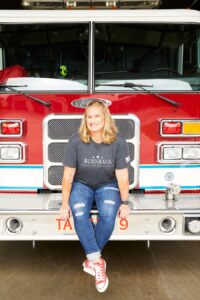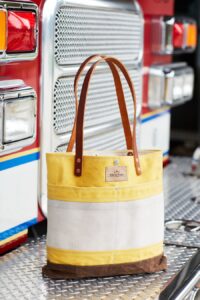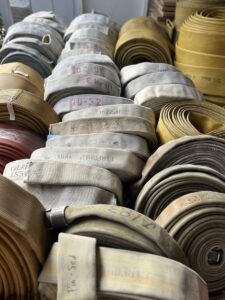Through the windows of the mud room in her house in Summerfield, N.C., Janelle Robinson can see her farm: miniature cows, chickens, turkeys. The mud room doubles as her office, where she makes her “Burn Bags” — tote bags made from heavy-duty canvas, leather, and repurposed fire hose.
Burn Bags are sturdy things. They stand up on their own. The body of the bag is waxed canvas, in deep colors like red, blue, and green. The leather straps are long and thick. Across the front of each bag is a pocket — that part is always made from fire hoses: yellow or white, permanently discolored from years of use. And some of that wear and tear — at least on certain specially made bags — happened in Provincetown.

Two years ago, Robinson got a roll of old fire hose in the mail from a fan in 02657. Jay Gurewitsch, the owner of Arcadia, a Provincetown shop devoted to handmade and sustainable goods, had seen her bags online months earlier, but it took some time to gather the local fire hoses that were destined for the dump.
Last winter, Laura Ludwig, who runs the marine debris program at the Center for Coastal Studies, mentioned to Gurewitsch that fire-hose materials never degrade, and that got him thinking. “I started doing searches online for cool things made from fire hose and was very disappointed,” he says, “until I came across Janelle’s work.”
When Gurewitsch finally sent a roll of Provincetown line to her shop, it was too late to get the custom-made bags for summer or even for the holiday shopping season. “I didn’t care,” he says. “We’re a year-round business, and I knew they would sell even in January.”
He was right; the bags are a hit here. Of course, people who have a Provincetown Fire Dept. I.D. get a big discount on the bags. Gurewitsch also donates $10 for each bag he orders to the Provincetown Food Pantry.
By the time Gurewitsch connected with her, Robinson had her fire-hose bags pretty well perfected. But her enterprise started small.
In 2018, her first year on the job as a volunteer firefighter-EMT at the fire dept. in Summerfield, Robinson noticed a pile of discarded fire hoses in the back of the station. The material caught her eye. “I asked my chief if I could take some home and try to make something out of it,” she says.
“I’ve always had what I call a side hustle,” she adds.

Robinson’s the kind of person who learned enough carpentry by watching YouTube videos to make her husband a cornhole board. “The girls in my book club wanted to make them for their husbands, too,” she says. A carpentry operation began: for five years, she taught women how to build furniture. Her basement became a woodshop.
“We had a Furniture 101 class where they made a bench,” says Robinson. At the end of the class, she says, she told her students: “You can stand on this bench. You can jump up and down. You’re going to have this bench in 20 years.” When the women graduated from bench-making, she taught them how to make bookshelves and kitchen tables. “My goal was always to make enough money to get my house cleaned,” says Robinson.
So, upon finding a new motherlode — fire hoses destined for the dump — Robinson set her mind to a new venture. “I tried a couple different things,” she says. “Dog beds and gun holders.” But those weren’t original enough for her.
Robinson made the first 500 bags in her mud room by herself. After that, she began to recruit help, and now women from the local recovery program, Tabitha Ministry, which assists women transitioning back into society after prison, addiction, or abusive situations, make bags with her.
Fire hose proved a difficult material to work with. “It’s a unique fabric,” she says — made of rubber covered in a woven polyester and nylon sheath. “The weave, the thread — once you cut it, it just pulls and pulls and pulls. I had to learn how to handle it.” She reached out to sewing experts around the country. “I sent them some fabric, and they agreed: this is a totally unique situation.”
She ended up designing around its demands. For example: she couldn’t place the hose on a weight-bearing seam, she says. “That’s why the hose material is a front pocket — it’s not holding the weight of the straps.” She learned to use a stabilizer fabric, attached behind the hose, to strengthen it and allow for more ease of sewing.
In her home office, which is really more of a factory, Robinson and her assistants do all the prep work. They buy the leather that they’ll use for the bag straps. “It’s water buffalo,” says Robinson. “I buy it by the half-buffalo.” With small hand tools — circle punches and hammers and leather-cutters — Robinson and her assistants slice and punch the leather into bag straps.
Robinson made her first 100 bags using a regular sewing machine. “I would break needles all the time,” she says. “At least two needles per bag.”
She moved on to a used industrial sewing machine. “It’s all metal,” she says, “and comes with a big table.” She oils it to keep it running smoothly. “It would sew right up your hand if you weren’t paying attention. It wouldn’t even blink.”

Now that her business is bigger, Robinson sources her fire hoses from fire stations in a broader area. They’ll send her a hose that failed to meet National Fire Protection Association standards during annual testing.
“Or if they have a line — we call hose a line — that goes bad, gets a hole in it or gets run over by a car, they call me,” she says. Robinson sends her two teenagers over in a truck to collect the stuff. They keep rolls of hose in a barn on their property. When it’s time to use it, Robinson and her assistants wash the hose to remove contaminants, then cut it down to size.
Robinson tucks two cards inside each finished bag: an “authenticity tag,” that tells which fire station the hose came from, and a mission card that tells about the women of her workshop. Each bag also contains what she calls a “giving bag”: a small bag with a card in it that asks the buyer to fill it with goodies — spaghetti, Gatorade, bagged salad — and drop it off at their local fire station. “Firefighters work 24-hour shifts,” says Robinson. “They need three meals a day.”
Robinson carries one of her bags on the daily: a gray-and-blue number. People have started to recognize the brand. Recently, she says, she was boarding a plane in Miami wearing her Burn Bags T-shirt. From the other end of the plane, she says, “a lady held up her Burn Bag to show me.”



